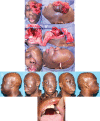Reconstructive Outcomes of Multilayered Closure of Large Skull Base Dural Defects Following Open Anterior Craniofacial Resection
- PMID: 35903650
- PMCID: PMC9324318
- DOI: 10.1055/s-0041-1722899
Reconstructive Outcomes of Multilayered Closure of Large Skull Base Dural Defects Following Open Anterior Craniofacial Resection
Abstract
Introduction Standardized reconstruction protocols for large open anterior skull base defects with dural resection are not well described. Here we report the outcomes and technique of a multilayered reconstructive algorithm utilizing local tissue, dural graft matrix, and microvascular free tissue transfer (MVFTT) for reconstruction of these deformities. Design This study is a retrospective review. Results Eleven patients (82% males) met inclusion criteria, with five (45%) having concurrent orbital exenteration and eight (73%) requiring maxillectomy. All patients required dural resection with or without intracranial tumor resection, with the average dural defect being 36.0 ± 25.9 cm 2 . Dural graft matrices and pericranial flaps were used for primary reconstruction of the dural defects, which were then reinforced with free fascia or muscle overlay by means of MVFTT. Eight (73%) patients underwent anterolateral thigh MVFTT, with the radial forearm, fibula, and vastus lateralis comprising the remainder. Average total surgical time of tumor resection and reconstruction was 14.9 ± 3.8 hours, with median length of hospitalization being 10 days (IQR: 9.5, 14). Continuous cerebrospinal fluid drainage through a lumber drain was utilized in 10 (91%) patients perioperatively, with an average length of indwelling drain of 5 days. Postoperative complications occurred in two (18%) patients who developed asymptomatic pneumocephalus that resolved with high-flow oxygen therapy. Conclusion A standardized multilayered closure technique of dural graft matrix, pericranial flap, and MVFTT overlay in the reconstruction of large open anterior craniofacial dural defects can assist the reconstructive team in approaching these complex deformities and may help prevent postoperative complications.
Keywords: anterior craniofacial resection; head and neck cancer; microvascular free tissue transfer; reconstruction; skull base.
Thieme. All rights reserved.
Conflict of interest statement
Conflict of Interest None declared.
Figures




References
-
- Smith R R, Klopp C T, Williams J M. Surgical treatment of cancer of the frontal sinus and adjacent areas. Cancer. 1954;7(05):991–994. - PubMed
-
- Ketcham A S, Wilkins R H, Vanburen J M, Smith R R. A combined intracranial facial approach to the paranasal sinuses. Am J Surg. 1963;106:698–703. - PubMed
-
- Zimmer L A, Theodosopoulos P V. Anterior skull base surgery: open versus endoscopic. Curr Opin Otolaryngol Head Neck Surg. 2009;17(02):75–78. - PubMed
-
- Kuan E C, Badran K W, Yoo F. Predictors of short-term morbidity and mortality in open anterior skull base surgery. Laryngoscope. 2018:1–6. - PubMed
-
- Eloy J A, Vivero R J, Hoang K. Comparison of transnasal endoscopic and open craniofacial resection for malignant tumors of the anterior skull base. Laryngoscope. 2009;119(05):834–840. - PubMed
LinkOut - more resources
Full Text Sources
Miscellaneous

